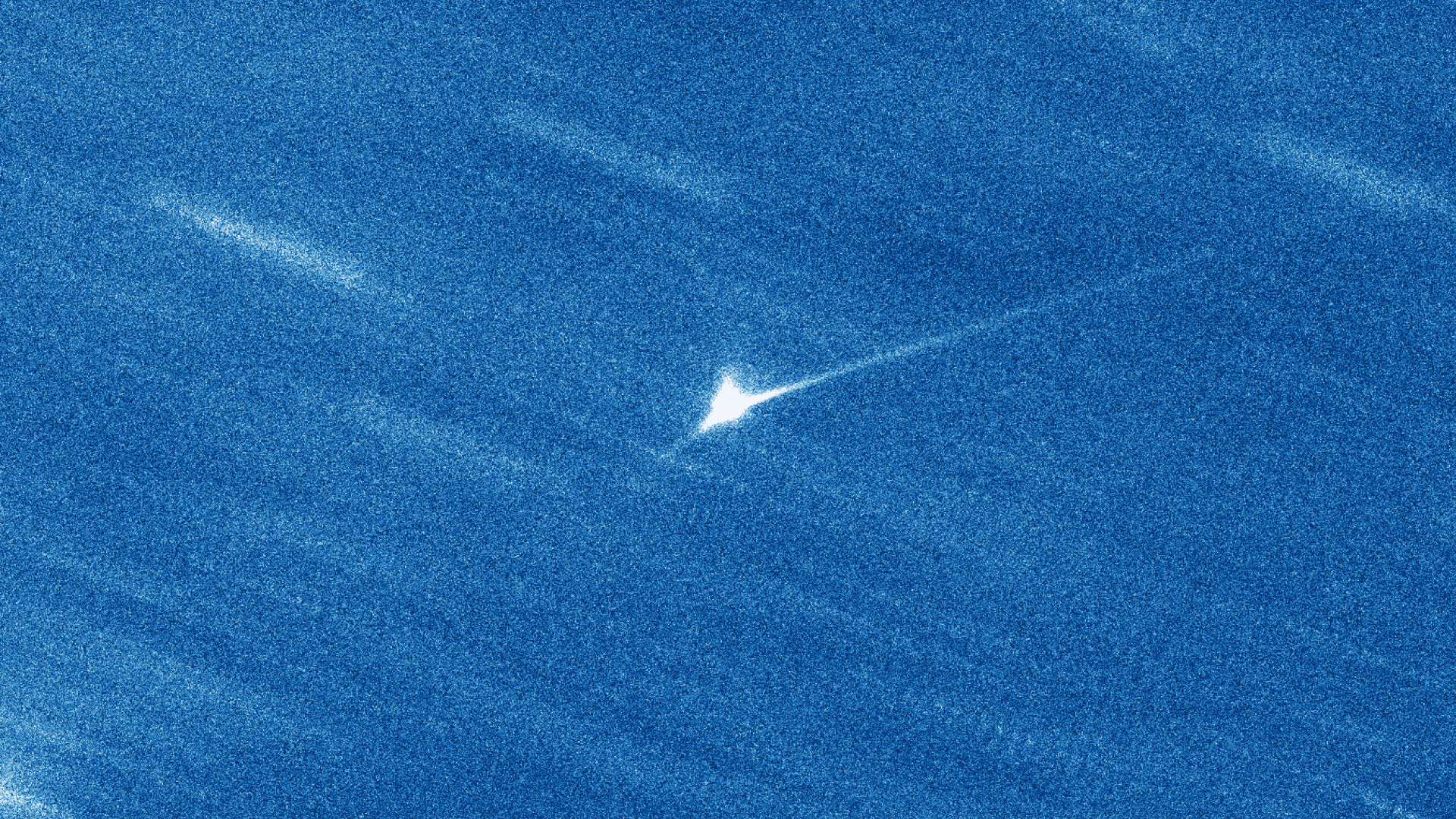
Six months after NASA slammed a spacecraft into an asteroid at high speed, scientists are beginning to gain a clearer picture of the mission's target.
Careful scrutiny of the debris from the impact of NASA's DART mission into Dimorphos has not found any evidence for water-ice on the asteroid, nor the residue of thruster fuel from the spacecraft, new results from the European Southern Observatory (ESO) show.
However, the data from the MUSE (Multi-Unit Spectroscopic Explorer) instrument on ESO's Very Large Telescope in Chile does indicate differences in the size of particles in the debris, and show how the polarization of the light from the asteroid changed. These could both reveal details about the nature of the ejecta excavated by the impact, the recoil from which gave Dimorphos the biggest push.
Related: NASA's DART asteroid-smashing mission: The ultimate guide

DART, the Double Asteroid Redirection Test, was a mission to nudge an asteroid, the 580-foot (177-meter) Dimorphos, while in its orbit around its binary companion, the 2,788-feet-wide (850 meters) Didymos. Aiming to show that it is possible to move potentially Earth-threatening asteroids off of their current trajectories, DART slammed into Dimorphos on Sept. 26 2022, altering its orbital period by 33 minutes.
"Before the impact, we were not really sure what to expect," said Cyrielle Opitom of the University of Edinburgh in an interview with Space.com.
Asteroids are mostly rocky and are often held loosely together by gravity, but the presence of water ice on some asteroids remains a talking point. In 2009 the asteroid 24 Themis was shown to have water ice on its surface in observations by NASA's Infrared Telescope Facility in Hawaii, though how the ice came to be there remains uncertain. One theory suggests that there is a layer of ice beneath the surface of some asteroids, which may have formed farther out from the sun before migrating inwards. It has even been postulated that asteroids may have delivered Earth's water to our planet.
Opitom led a team who used MUSE to go in search of any water on Dimorphos. They observed the Didymos–Dimorphos system on 11 occasions, from just before the impact to about a month afterwards. MUSE is able to split the light from the double-asteroid into a spectrum, or rainbow, of colors, to look for emission at specific wavelengths that corresponds to specific molecules. In particular, Opitom's team searched the ejecta for water molecules and for oxygen that could have come from the break-up of water molecules by the impact. However, no evidence of water was detected. Dimorphos, at least, seems to be a dry asteroid.
There was also no evidence in the ejecta of traces of the hydrazine fuel that was on board DART, nor the xenon from its ion engine, although given their small quantities the non-detection is not a surprise.
However, MUSE's observations were able to track the evolution of the cloud of ejecta (debris) thrown up by the impact, and in particular they helped determine the size distribution of the dust particles initially in the ejecta cloud and later in the tail streaming away from the asteroid.

When DART slammed into Dimorphos, it released an estimated 900,000 kilograms of dust into space. The VLT–MUSE observations showed fast moving ejecta racing away from the impact site, and then after a few hours the pressure of sunlight pushed on the dust, combined with the gravity of neighboring Didymos, causing the cone-shaped ejecta cloud to twist. Later, over the following weeks, a dust tail grew.
The VLT observations neatly correlate with those of the Hubble Space Telescope that were released in March.
"From the Hubble observations, they determined that around the moment [the tail] appeared, the tail is composed of particles in the 1-10 micron range," said Opitom. "Because our [observations] have a lower spectral resolution and sensitivity than the Hubble observations, we did not see the tail at that time. We only detected it later, when it was dominated by slightly larger particles."
This is consistent, Opitom said, with the color of the ejecta as detected by the VLT and MUSE, with light scattered off smaller dust particles appearing bluer and light scattered of larger dust particles appearing redder.
"The tail appears in our data as redder than the ejecta, which was slightly bluer than the tail," said Opitom. Hence, the initial ejecta cloud contained slightly smaller dust particles than the slower dust left behind in the long tail.
DART didn't just succeed in pushing an asteroid — it gave astronomers an opportunity to watch an asteroid get impacted by another object in real time. Astronomers have previously found evidence of asteroids that have grown tails, known as active asteroids, and at least some of these may be the result of impacts.
"DART was a unique opportunity, because we knew precisely the time of impact, the mass and the properties of the impactor," said Opitom. "We have incredible images of the surface and the aftermath of the impact was also observed with a variety of instruments. Combining all this information will help us build a detailed picture of what happened and it will greatly help us interpret observations of impacts on other asteroids."
The research was published on March 21 in the journal Astronomy & Astrophysics.
Follow Keith Cooper on Twitter @21stCenturySETI. Follow us on Twitter @Spacedotcom and on Facebook.







